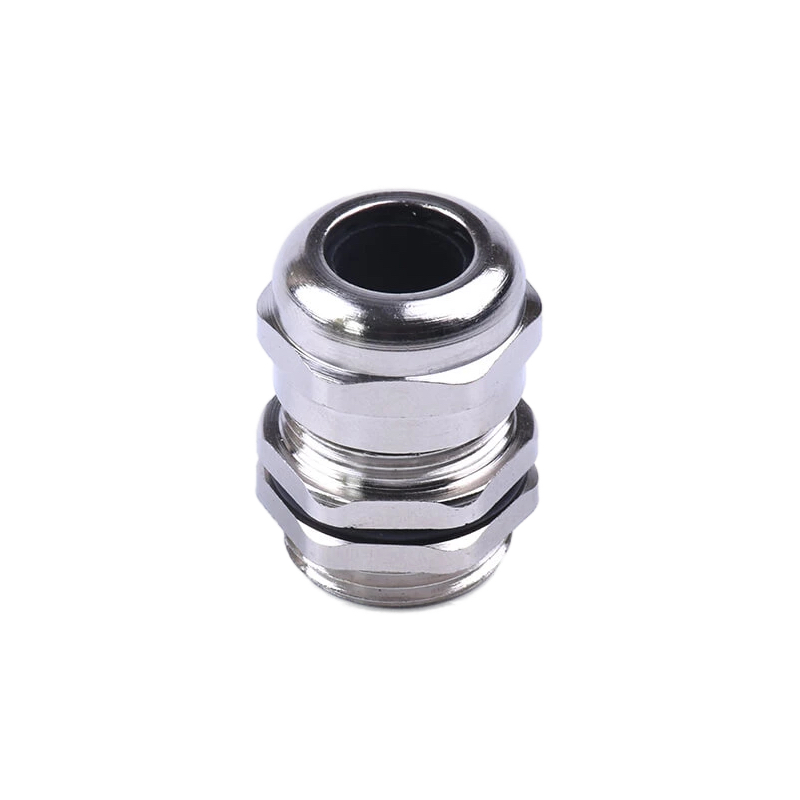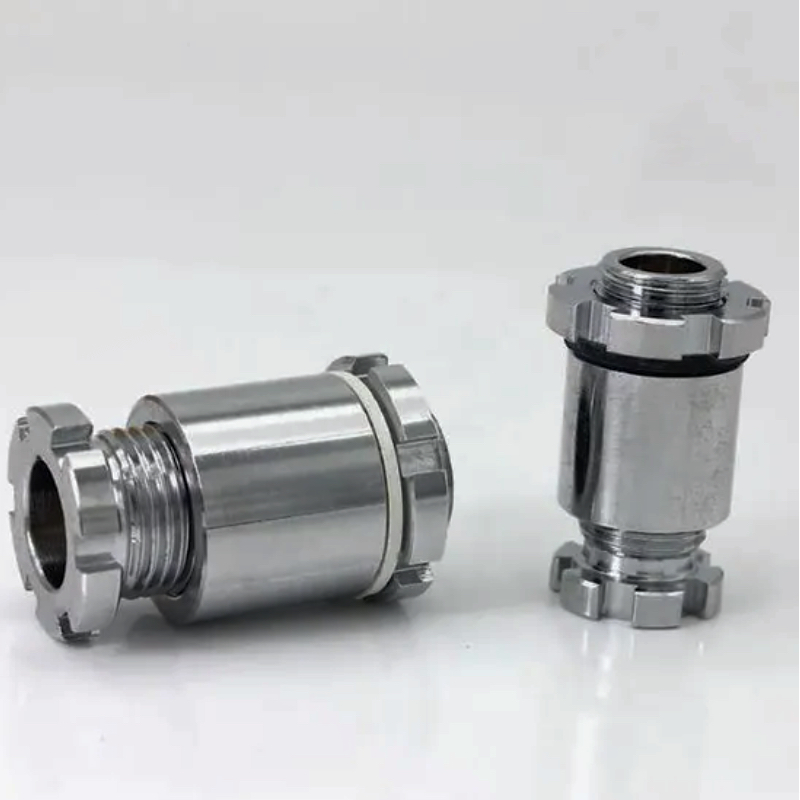Standard brass cable glands fail catastrophically in corrosive environments, leaving engineers scrambling for costly replacements and dealing with unexpected downtime. The frustration of watching expensive installations deteriorate within months instead of years has driven countless professionals to seek better solutions. Traditional brass simply can’t handle the aggressive conditions found in modern industrial applications.
Nickel-plated brass cable glands combine the excellent electrical conductivity of brass with enhanced corrosion resistance through electroplated nickel coating, delivering 5-10 times longer service life than unplated brass in corrosive environments. This surface treatment creates a protective barrier that maintains brass’s superior conductivity while dramatically improving durability.
After witnessing hundreds of brass cable gland failures across diverse industrial sectors, I’ve seen how nickel plating transforms performance outcomes. Let me share the scientific principles and real-world applications that make nickel-plated brass the optimal choice for challenging environments where both conductivity and corrosion resistance are critical.
Table of Contents
- What Is the Science Behind Nickel Plating on Brass Cable Glands?
- How Does Nickel Plating Enhance Corrosion Resistance?
- What Are the Performance Advantages in Real-World Applications?
- How Do Nickel-Plated Brass Cable Glands Compare to Other Materials?
- FAQ
What Is the Science Behind Nickel Plating on Brass Cable Glands?
Understanding the electrochemical principles behind nickel plating reveals why this surface treatment delivers such dramatic performance improvements for brass cable glands.
Nickel plating creates a uniform, dense metallic coating through electrodeposition1 that forms a protective barrier while maintaining the substrate’s beneficial properties. The process involves precise control of current density, temperature, and chemical composition to achieve optimal adhesion and thickness.

The Electroplating Process
At Bepto Connector, our nickel plating process follows strict ISO90012 protocols to ensure consistent quality:
- Surface Preparation: Thorough cleaning removes oils, oxides, and contaminants
- Activation: Acid etching creates optimal surface energy for adhesion
- Strike Plating: Thin nickel layer (0.5-1.0 μm) ensures uniform coverage
- Build-up Plating: Main nickel layer (5-25 μm) provides corrosion protection
- Final Treatment: Passivation or chromate conversion for enhanced durability
Metallurgical Properties
The nickel coating exhibits specific characteristics that enhance brass performance:
- Thickness range: 5-25 micrometers depending on application requirements
- Hardness: 150-600 HV (significantly harder than brass substrate)
- Porosity: <0.1% when properly applied
- Adhesion strength: >30 MPa bond strength to brass substrate
- Crystal structure: Face-centered cubic, providing excellent ductility
I remember working with Marcus, a chief engineer at a major petrochemical facility in Texas, who was skeptical about plating effectiveness. After conducting accelerated corrosion testing on our nickel-plated brass cable glands versus unplated alternatives, he was amazed to see 1000+ hour salt spray resistance compared to less than 100 hours for standard brass. That data convinced him to specify nickel-plated brass for their entire expansion project.
Coating Uniformity and Quality Control
Achieving consistent nickel plating requires precise process control:
| Parameter | Specification | Impact on Quality |
|---|---|---|
| Current density | 2-6 A/dm² | Controls deposition rate and grain structure |
| Temperature | 50-60°C | Affects coating stress and adhesion |
| pH level | 3.5-4.5 | Influences coating brightness and hardness |
| Agitation rate | 0.5-1.0 m/s | Ensures uniform thickness distribution |
| Plating time | 15-45 minutes | Determines final coating thickness |
How Does Nickel Plating Enhance Corrosion Resistance?
The corrosion protection mechanisms of nickel plating operate through multiple complementary pathways that dramatically extend cable gland service life.
Nickel plating provides both barrier protection and galvanic protection, creating a dual-defense system against corrosive attack. The coating acts as a physical barrier while also providing cathodic protection to the underlying brass substrate.
Barrier Protection Mechanism
Nickel’s inherent corrosion resistance stems from its ability to form stable oxide films:
- Passive film formation3: NiO and Ni(OH)₂ layers form naturally in oxidizing environments
- Self-healing properties: Minor coating damage automatically repairs through repassivation
- Chemical inertness: Excellent resistance to most industrial chemicals and solvents
- Moisture barrier: Dense coating prevents water penetration to brass substrate
Galvanic Protection Analysis
The electrochemical relationship between nickel and brass provides additional protection:
Standard Electrode Potentials4 (vs. SHE):
- Nickel: -0.25V
- Copper (brass component): +0.34V
- Zinc (brass component): -0.76V
This arrangement means nickel acts as a sacrificial anode, protecting the brass substrate even if the coating is damaged. However, the slow corrosion rate of nickel ensures long-term protection without significant coating loss.
Environmental Performance Data
Our extensive testing reveals dramatic improvements in corrosive environments:
Salt Spray Testing (ASTM B117):
- Unplated brass: 24-96 hours to red rust
- Nickel-plated brass: 1000+ hours without base metal corrosion
Industrial Atmosphere Exposure:
- Standard brass: 6-18 months to visible corrosion
- Nickel-plated brass: 5-10 years maintenance-free operation
Chemical Resistance:
- Acids (pH 3-6): Excellent resistance vs. poor for brass
- Alkalis (pH 8-11): Good resistance vs. moderate for brass
- Organic solvents: Excellent resistance for both materials
What Are the Performance Advantages in Real-World Applications?
Real-world performance data from thousands of installations demonstrates the practical benefits of nickel-plated brass cable glands across diverse industrial sectors.
Nickel-plated brass cable glands deliver 300-500% longer service life than unplated brass in corrosive environments while maintaining superior electrical conductivity. This performance advantage translates directly into reduced maintenance costs and improved system reliability.
Marine and Offshore Applications
Working with Hassan, who manages offshore wind installations in the North Sea, provided invaluable insights into marine performance. His initial brass cable gland installations failed within 8-12 months due to salt spray corrosion, causing expensive helicopter maintenance visits.
After switching to our nickel-plated brass cable glands:
- Service life: Extended to 7+ years without replacement
- Maintenance costs: Reduced by 75% due to elimination of premature failures
- Electrical performance: Maintained excellent conductivity for grounding systems
- Installation efficiency: No special handling requirements compared to stainless steel
Chemical Processing Environments
Chemical plants present unique challenges where nickel plating proves invaluable:
Case Study – Pharmaceutical Manufacturing:
- Environment: Frequent washdown with disinfectants and cleaning chemicals
- Previous solution: Stainless steel (expensive, poor conductivity)
- Nickel-plated brass results:
– 40% cost reduction vs. stainless steel
– Superior EMC performance due to brass conductivity
– 5+ year service life with minimal maintenance
Automotive Manufacturing
The automotive industry’s demanding requirements showcase nickel plating advantages:
| Application Area | Unplated Brass Performance | Nickel-Plated Brass Performance |
|---|---|---|
| Paint booth environments | 6-12 months service life | 5+ years service life |
| Wash systems | Frequent replacement needed | Maintenance-free operation |
| Assembly line humidity | Visible corrosion in 3-6 months | No visible corrosion after 3+ years |
| EMC test chambers | Good electrical performance | Excellent long-term stability |
Temperature Cycling Performance
Nickel plating maintains integrity through thermal cycling:
- Thermal expansion compatibility: Nickel coefficient (13.4 × 10⁻⁶/°C) closely matches brass
- Adhesion retention: >95% bond strength maintained after 1000 thermal cycles
- Coating integrity: No cracking or spalling observed in -40°C to +120°C cycling
How Do Nickel-Plated Brass Cable Glands Compare to Other Materials?
Comprehensive material comparison reveals where nickel-plated brass delivers optimal value versus alternative solutions like stainless steel, aluminum, or plastic cable glands.
Nickel-plated brass cable glands offer the ideal balance of electrical conductivity, corrosion resistance, and cost-effectiveness for most industrial applications. This combination is unmatched by any single alternative material.
Performance Matrix Comparison
| Property | Nickel-Plated Brass | Stainless Steel | Aluminum | Nylon |
|---|---|---|---|---|
| Electrical conductivity | Excellent (25% IACS5) | Poor (3% IACS) | Good (60% IACS) | None |
| Corrosion resistance | Excellent | Excellent | Good | Excellent |
| Mechanical strength | Good (400-500 MPa) | Excellent (580+ MPa) | Moderate (200-300 MPa) | Poor (80-120 MPa) |
| Cost effectiveness | Excellent | Poor | Good | Excellent |
| Temperature range | -40°C to +120°C | -200°C to +400°C | -40°C to +150°C | -40°C to +100°C |
| Machinability | Excellent | Moderate | Good | Excellent |
Total Cost of Ownership Analysis
Five-year lifecycle cost comparison for 1000-piece installation:
Standard Industrial Environment:
- Nickel-plated brass: $4,500 initial + $500 maintenance = $5,000 total
- Stainless steel: $7,000 initial + $200 maintenance = $7,200 total
- Unplated brass: $3,000 initial + $2,500 replacement/maintenance = $5,500 total
Corrosive Environment:
- Nickel-plated brass: $4,500 initial + $800 maintenance = $5,300 total
- Stainless steel: $7,000 initial + $300 maintenance = $7,300 total
- Unplated brass: $3,000 initial + $6,000 replacement/maintenance = $9,000 total
Application-Specific Recommendations
Based on 10+ years of field experience, here are my recommendations:
Choose Nickel-Plated Brass When:
- EMC shielding is critical
- Moderate to high corrosion resistance needed
- Cost optimization is important
- Standard temperature ranges (-40°C to +120°C)
- Easy installation and maintenance preferred
Choose Stainless Steel When:
- Extreme corrosion resistance required
- High-temperature applications (>150°C)
- Maximum mechanical strength needed
- Long-term maintenance-free operation essential
Choose Aluminum When:
- Weight reduction is critical
- Non-magnetic properties required
- Moderate electrical conductivity acceptable
- Budget constraints are primary concern
Conclusion
Nickel-plated brass cable glands represent the optimal engineering solution for applications requiring both excellent electrical conductivity and enhanced corrosion resistance. The science behind nickel plating creates a synergistic combination that delivers performance characteristics unmatched by any single material alternative.
At Bepto Connector, we’ve perfected our nickel plating process to consistently deliver 5-25 μm coatings that provide 5-10 times longer service life than unplated brass in corrosive environments. This technology bridges the gap between cost-effective brass and premium stainless steel, offering the ideal balance for most industrial applications. When you need reliable performance without premium pricing, nickel-plated brass cable glands deliver proven results that stand the test of time.
FAQ
Q: How thick should nickel plating be on cable glands?
A: Optimal nickel plating thickness ranges from 10-25 micrometers for most industrial applications. Thinner coatings (5-10 μm) work for mild environments, while thicker coatings (20-25 μm) provide maximum protection in aggressive conditions like marine or chemical processing environments.
Q: Can nickel-plated brass cable glands be used in food processing applications?
A: Yes, nickel-plated brass cable glands are suitable for food processing when the nickel plating meets FDA requirements. The coating provides excellent resistance to cleaning chemicals and sanitizers commonly used in food facilities, while maintaining electrical conductivity for grounding systems.
Q: What’s the difference between bright nickel and satin nickel plating?
A: Bright nickel plating provides a mirror-like finish with slightly higher hardness, while satin nickel offers a matte appearance with better ductility. Both provide equivalent corrosion protection, but satin nickel is preferred for applications requiring better coating flexibility during installation.
Q: How do I verify nickel plating quality on cable glands?
A: Quality nickel plating should show uniform appearance without pitting, blisters, or discoloration. Professional verification includes thickness measurement using magnetic or X-ray methods, adhesion testing per ASTM B571, and salt spray testing per ASTM B117 for corrosion resistance validation.
Q: Can damaged nickel plating be repaired in the field?
A: Minor nickel plating damage can be temporarily protected with appropriate touch-up coatings, but proper repair requires re-plating in a controlled facility. For critical applications, damaged cable glands should be replaced rather than field-repaired to maintain optimal corrosion protection.
-
Learn about the process of electrodeposition, where metal ions in a solution are deposited onto a conductive object to form a coating. ↩
-
Review the official standard for quality management systems from the International Organization for Standardization. ↩
-
Understand how a passive film, a non-reactive layer, forms on the surface of metals and protects them from corrosion. ↩
-
Explore a table of standard electrode potentials to understand the tendency of different metals to be oxidized or reduced. ↩
-
Learn about the IACS, a benchmark used to compare the electrical conductivity of different metals relative to pure copper. ↩




